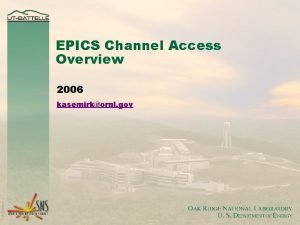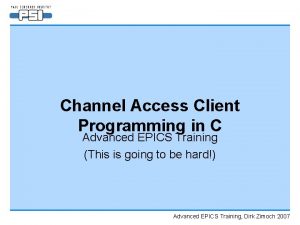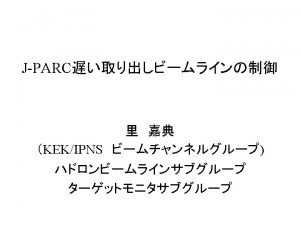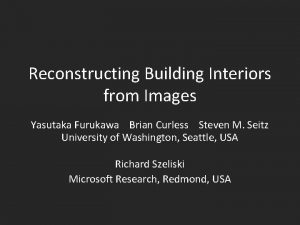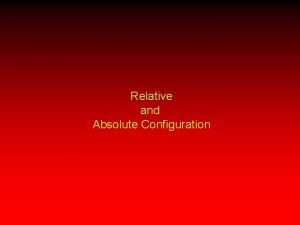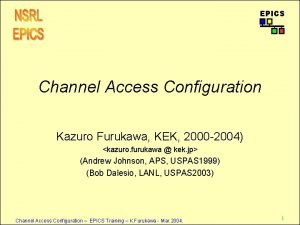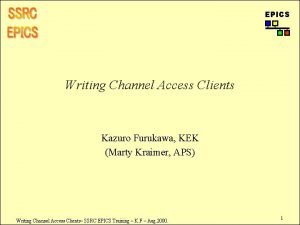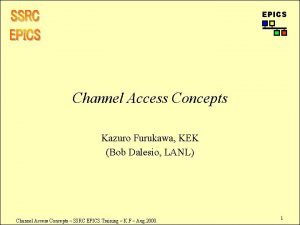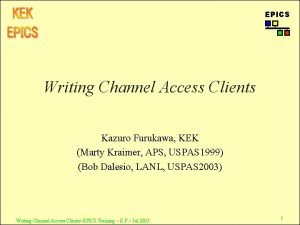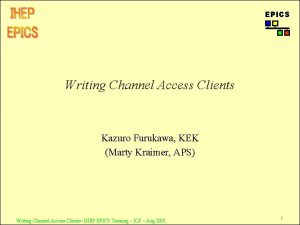EPICS Channel Access Configuration Kazuro Furukawa KEK Andrew








- Slides: 8

EPICS Channel Access Configuration Kazuro Furukawa, KEK (Andrew Johnson, APS, USPAS 1999) Channel Access Configuration – EPICS Training – K. F - Jul. 2003. 1

Configuration method u u CA clients and servers can be configured by setting environment variables On Unix: u u u putenv "VARNAME=value" env. Show displays all variable values Environment variables are inherited when you start a new program, not afterwards u u u csh, tcsh — setenv VARNAME value sh, ksh — VARNAME=value; export VARNAME printenv displays all variables from any shell On vx. Works: u u EPICS Unix: Set the variables, then start the client vx. Works: Set variables in the startup script Default values for a site are set at build-time in <epics>/base/config/CONFIG_ENV and <epics>/base/config/CONFIG_SITE_ENV Channel Access Configuration – EPICS Training – K. F - Jul. 2003. 2

CA name resolution u u Search requests for CA channel names are broadcast to all CA servers on the client’s local TCP/IP subnet Only a server which recognizes the name will respond to the client u u u EPICS If identical record names exist in two IOCs, the first to reply “wins” the connection The client library then opens a connection with that server to access that channel Potential problems: u Not all LANs support broadcasting u u Some sites don’t allow broadcasting u u Ethernet does, Token Ring doesn’t Bridges/hubs will not forward packets Broadcasts are local to the machine’s subnet u Sites can span more than a single subnet Channel Access Configuration – EPICS Training – K. F - Jul. 2003. 3

Configuring name resolution u How to disable all broadcasts? u EPICS_CA_AUTO_ADDR_LIST = NO u Default value = YES IOCs are also clients, so generate broadcasts u u EPICS How to find channels without broadcast? u EPICS_CA_ADDR_LIST u List of IP addresses, separated by spaces setenv EPICS_CA_ADDR_LIST "164. 54. 8. 145" u u This list is used in addition to broadcasts if these are enabled How to search other subnets as well? u Use a broadcast address in EPICS_CA_ADDR_LIST setenv EPICS_CA_ADDR_LIST "131. 111. 69. 255" u Some routers will not pass broadcast addresses Channel Access Configuration – EPICS Training – K. F - Jul. 2003. 4

Connection health u CA servers send out an “I’m still here” beacon ever 15 seconds u u Usually broadcast, configurable as before If a server is quiet for 30 seconds, any connected clients will u u EPICS send it an “echo” packet (not broadcast) allow 5 seconds for it to reply mark all channels to this server disconnected Potential problems: u u u Slow or busy links might introduce random delays, some longer than 15 seconds Busy sites may want to reduce broadcast rates Clients take 35 seconds to recognize when a server has died Channel Access Configuration – EPICS Training – K. F - Jul. 2003. 5

Configuring connection health u u How to change the server beacon period? u putenv "EPICS_CA_BEACON_PERIOD=30. 0" u Default value is 15. 0 seconds How to change the client timeout delay? u setenv EPICS_CA_CONN_TMO 60. 0 u Default value is 30. 0 seconds This value determines how long a client takes to notice that a server has died (+5 seconds) u u EPICS The connection timeout must be longer than the beacon period, preferably twice u u Breaking the ‘preferred’ condition could increase network traffic Breaking the ‘must be’ condition can also cause random client disconnections Channel Access Configuration – EPICS Training – K. F - Jul. 2003. 6

Port numbers u Channel Access uses two IP port numbers for its communication (UDP and TCP) u u u EPICS_CA_SERVER_PORT u Default is 5064 EPICS_CA_REPEATER_PORT u Default is 5065 Both should be > 5000, check with sysadmins The settings for a server and all its clients must be the same Using different port numbers can allow independent projects to share a subnet without any danger of CA name clashes u u Can also be used for application testing No interaction is possible between projects Channel Access Configuration – EPICS Training – K. F - Jul. 2003. 7

Where am I — What time is it? u EPICS An IOC gets Universal Coordinated Time from its boot host (UTC=GMT) u This is converted to local time using the server’s value for EPICS_TS_MIN_WEST u u CA Servers report timestamp values using their local timezone How to tell a client that the server is in a different timezone? u setenv EPICS_TS_MIN_WEST -480 u u u Default value is set by site manager (APS=360) Gives server’s timezone in minutes relative to GMT; negative means east of Greenwich Daylight savings changes are hard-coded into the IOC software. Changes may occur on the wrong date in some locations… Channel Access Configuration – EPICS Training – K. F - Jul. 2003. 8
